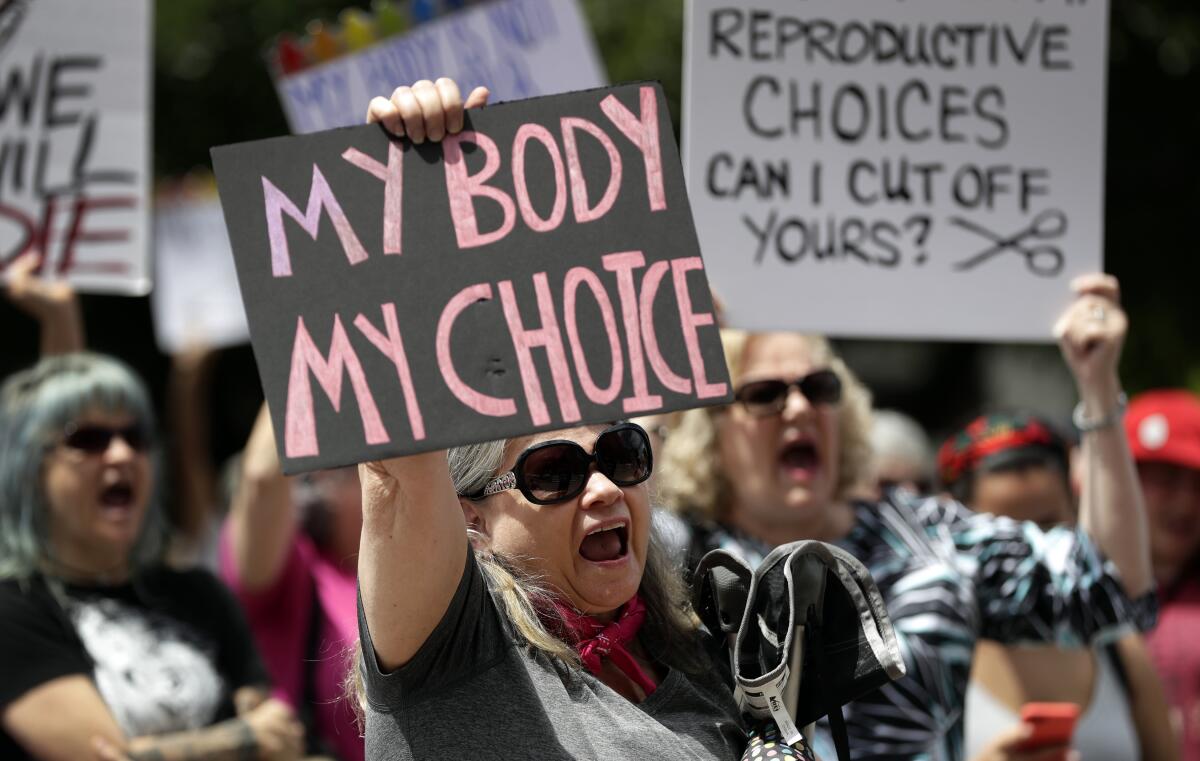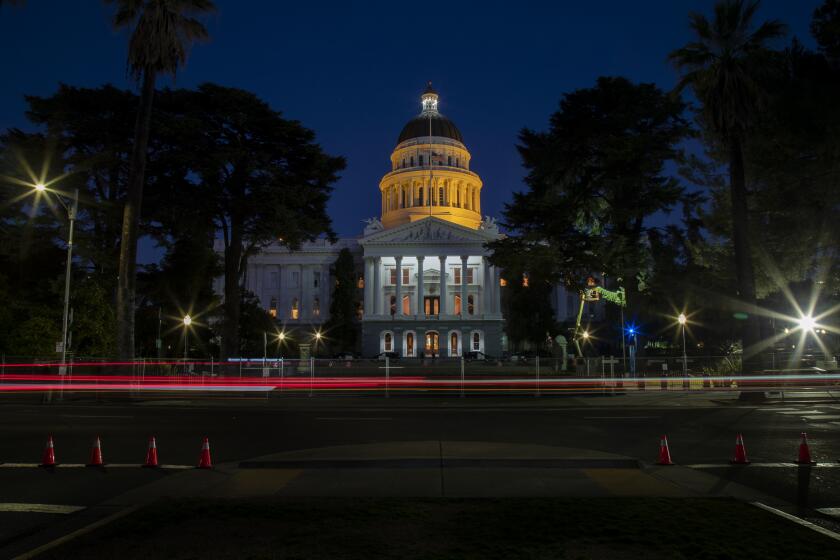California makes plans to be the nation’s abortion provider in a post-Roe world

- Share via
SACRAMENTO — With access to abortion at stake across the U.S., California is getting ready to become the nation’s abortion provider.
Democratic Gov. Gavin Newsom and legislative leaders have asked a group of reproductive health experts to propose policies to bolster the state’s abortion infrastructure and prepare it for more patients. Lawmakers plan to begin debating the ideas when they reconvene in January.
For the record:
4:52 p.m. Nov. 15, 2021An earlier version of this story included incorrect figures from the Guttmacher Institute on abortion providers in California and other states.
Abortion providers are already girding for a surge in demand.
Dr. Janet Jacobson, medical director of Planned Parenthood of Orange and San Bernardino counties, said three or four out-of-state patients visit her clinics each day — about double the number that sought treatment before a near-total ban on abortion took effect in Texas in September.
Though the nine clinics can absorb that slow trickle, they expect up to 50 out-of-state patients a week if the U.S. Supreme Court’s conservative majority guts abortion rights nationally, Jacobson said. She bases her estimate on new data from the Guttmacher Institute, a research organization that supports reproductive health and abortion rights.
She is adding to her staff and appointment capacity, hoping to accommodate everyone.
“We have to make sure we can still continue to care for all of our California patients,” Jacobson said. “We don’t want them getting squeezed out” of appointments.
The Texas law bans nearly all abortions after about six weeks of pregnancy and empowers private citizens to sue anyone who performs or “aids and abets” an abortion after that time.
The Supreme Court heard arguments in that case Nov. 1 and is expected to announce a ruling on its constitutionality in June. Nonetheless, Florida and Ohio have announced plans for copycat laws.
The Biden administration sued Texas and said its abortion law violates pregnant women’s constitutional rights. The Supreme Court delays a decision.
Next month the high court will hear another abortion case with even broader implications, Dobbs vs. Jackson Women’s Health Organization, a lawsuit challenging the constitutionality of a 2018 Mississippi law that prohibited abortion after 15 weeks. If the court sides with Mississippi, its decision could overturn existing abortion rights confirmed by 1973’s landmark Roe vs. Wade case.
Should that happen, reproductive rights experts predict, 26 states will ban the procedure altogether and states with stronger protections for abortion — like California — will draw even more patients. There could be up to a 3,000% increase in people who “may drive to California for abortion care” each year, according to the Guttmacher data.
In 2017, the most recent year for which data is available from Guttmacher, California — by far the nation’s most populous state — had more abortion providers than any other state, with 419 hospitals, clinics or doctors’ offices performing the procedure. The next highest were New York, with 252, and Florida, with 85. Neighboring Arizona and Nevada each had 11.
Of the 862,320 abortions performed in the U.S. that year, 132,680, or about 15%, were in California.
Planned Parenthood clinics in California say they already serve about 7,000 out-of-state patients a year and are expecting a surge of new ones, especially in travel hubs like the Los Angeles area.
In September, Planned Parenthood and groups such as Black Women for Wellness convened the California Future of Abortion Council with backing from influential Democratic leaders including Newsom, state Senate leader Toni Atkins (D-San Diego) and Assembly Speaker Anthony Rendon (D-Lakewood).
Atkins, who was the director of a San Diego women’s health clinic in the 1980s, said she spent time with women from states where it was hard to get an abortion. She said California is committed to ensuring abortion access in the state and beyond.
The council is focused on increasing funding for abortion services, providing logistical and financial help for women who need to travel, increasing the number of healthcare providers who perform abortions and strengthening legal protections for them.
Increasing capacity could mean licensing more practitioners to provide abortions or directing more resources into telehealth so people can see a doctor online to prescribe pills for a medical abortion — a service California doctors currently can provide to patients only within the state.
The most important thing the state should do is fix its shortage of providers, especially those who perform second-trimester abortions, which are more expensive and complicated than first-trimester abortions, said council member Dr. Daniel Grossman, director of the Advancing New Standards in Reproductive Health program at UC San Francisco.
It’s not feasible to place an abortion provider in every corner of the state, Grossman said. Instead, the council should focus on creating “hubs that can provide abortion care for large numbers of people” in easy-to-reach locations.
California already struggles to provide abortions to all who seek them, especially low-income women covered by Medi-Cal, California’s Medicaid program. For example, 28 counties — home to 10% of Medi-Cal recipients of childbearing age — don’t have facilities that provide abortions to Medi-Cal patients.
A medical abortion, in which drugs are used to terminate a pregnancy, costs California patients an average of $306 out of pocket, according to an analysis by the California Health Benefits Review Program, but isn’t available after 10 weeks. After that, the only option is a surgical abortion, which costs an average of $887 out of pocket in California.
One of the council’s likely recommendations will be to increase the rate Medi-Cal pays for abortions so more providers will perform them, said council member Fabiola Carrión, interim director for reproductive and sexual health at the National Health Law Program.
Medi-Cal pays $354.43 for a second-trimester abortion. A 2020 study in the journal Contraception found that states across the country paid between $79 and $626 for a second-trimester abortion in 2017.
Getting an abortion can be difficult for Californians who cannot afford one or live far from a clinic that provides the procedure.
Increasing Medi-Cal rates won’t help patients traveling from outside California. Generally, private insurance doesn’t cover out-of-state abortions, so most women will be on the hook for the full cost, and those enrolled in other states’ Medicaid programs must pay out of pocket, too.
The council hopes to reduce costs for state residents and visitors, said Brandon Richards, director of communications for Planned Parenthood Affiliates of California.
“It’s about making it easy for people to access abortion in California, whether they reside here or are coming in from out of state,” he said.
One way to target costs is by funding the practical support, like helping to pay for transportation, child care, hotels or time off work, said council member Jessica Pinckney, executive director of Access Reproductive Justice, a fund that helps people pay for abortions.
Pinckney said she’s working with Los Angeles County to set up a public abortion fund to cover some of those costs for anyone seeking an abortion in the county. It would be modeled after similar pots maintained by New York City; Austin, Texas; and Portland, Ore., and could eventually be a template for the first statewide fund, Pinckney said.
California lawmakers are debating a bill to eliminate out-of-pocket costs that proponents say often prevent people from obtaining abortions.
Most Texans seeking abortions since that state’s law took effect are going to nearby states like Colorado, New Mexico and Oklahoma, said Sierra Harris, deputy director of network strategies for the National Network of Abortion Funds. Women in those states, in turn, are having trouble getting care and are looking to California for appointments.
Practical support is important for out-of-state patients, said Alissa Perrucci, operations manager at the Women’s Options Center at Zuckerberg San Francisco General Hospital, one of five abortion clinics inside California hospitals.
Perrucci’s clinic is focusing on telemedicine, phone counseling and other ways to save time so it can add in-person appointments for out-of-state patients if necessary.
But more slots are useless if women can’t make it to California. The clinic says it has booked about 10 appointments for Texans since the state’s ban went into effect, but only half have shown up, mostly women with family connections in California.
“Most people just don’t have the money to get here,” Perrucci said.
“If the burden of abortion was borne predominantly by the wealthy, yeah, they’d just fly here.”
This story was produced by Kaiser Health News, one of the three major operating programs at the nonprofit Kaiser Family Foundation.
More to Read
Sign up for Essential California
The most important California stories and recommendations in your inbox every morning.
You may occasionally receive promotional content from the Los Angeles Times.
















